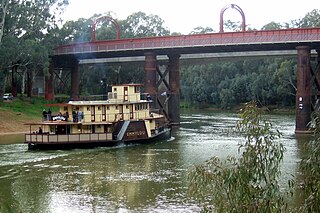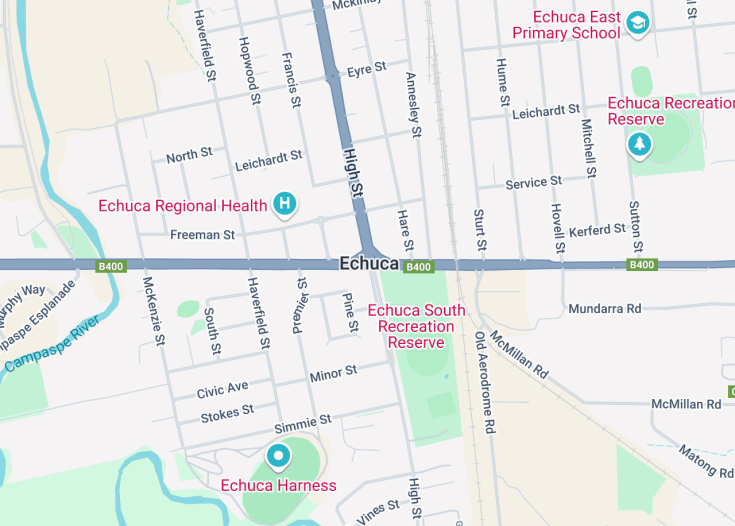Echuca, located on the banks of the mighty Murray River in Victoria, Australia, exudes a charming blend of historical significance and natural beauty. This picturesque town is renowned for its beautifully preserved paddle steamers and the bustling Port of Echuca, which stands as the largest inland port in Australia from the 19th century.
Visitors are treated to a glimpse of colonial life, complemented by modern amenities and leisure activities including river cruises, heritage walks, and winery tours. Echuca’s warm and welcoming atmosphere makes it a perfect getaway for families, history enthusiasts, and nature lovers.
Timing your visit in the cooler months from April to October offers a more pleasant experience for enjoying Echuca’s outdoor activities and historic tours.
Be sure to book a river cruise on one of the historic paddle steamers, a quintessential Echuca experience that offers a unique perspective of the town and its natural surroundings.
Top things to do & see in Echuca
Select the following sights and activities to discover best tickets and tours available in Echuca.
Echuca: Gateway to the Mighty Murray River
| Country | Australia |
| Time in Echuca | GMT+10 |
| Language spoken | English |
| Population | 14,028 (Australian Bureau of Statistics, 2021) |
| Currency | Australian Dollar (AUD $) |
| Airports |
|
Echuca, located in the northern part of Victoria, Australia, holds a special place in the history of the country’s inland navigation. The town sits on the banks of the Murray River, the longest river in Australia, which was once bustling with paddle steamers transporting cargo and passengers. This heritage is still vividly vibrant today with the historical precinct dedicated to showcasing the golden era of river trade, which has become a significant tourist attraction.
Echuca’s name comes from the Aboriginal word meaning “Meeting of the Waters,” signifying its role at the confluence of the Murray and Campaspe rivers. It was established in 1850 and quickly became one of Australia’s largest inland ports, an influential trade center during a time when road travel was arduous. The preservation of its historic port area, with the old wharves and warehouses, now museums, offers a glimpse into the bustling activities of yesteryears.
Today, Echuca remains a thriving community with its economy bolstered by agriculture and tourism. Visitors are attracted not only to its historical aspects but also to its vibrant community markets, unique festivals like the Winter Blues and roots festival, and scenic river experiences such as paddle steamer cruises.
In addition to historical tourism, Echuca is also a center for aquatic pleasures, providing ample opportunities for fishing, boating, and water skiing. The climate is generally dry and warm, characteristic of its location within the southern edge of Australia’s outback, making it a year-round destination for both history buffs and outdoor enthusiasts.
Echuca’s continued reverence for its historical and natural resources stands as a testament to its resilience and charm, making it a must-visit destination in Victoria.
Where is Echuca?
Echuca is situated on the northern edge of Victoria, near the Murray River and close to the border with New South Wales.
Distances:
| Route | Distance by car | Time by car |
|---|---|---|
| Melbourne to Echuca | 136 miles (219 km) | Approx. 2 hours 50 minutes |
| Sydney to Echuca | 439 miles (707 km) | Approx. 7 hours 45 minutes |
| Canberra to Echuca | 316 miles (509 km) | Approx. 5 hours 30 minutes |
What is Echuca famous for?
Echuca is most famous for its historic port, which was established in the 1850s, making it one of the busiest inland ports of its time due to trades and paddle steamers.
History
Pre-1850: Indigenous Heritage
The region around Echuca, known traditionally by the Yorta Yorta people, has a rich indigenous history that stretches back thousands of years. The Yorta Yorta utilized the abundant resources of the River Murray and surrounding forests, living in harmony with the land through hunting, fishing, and gathering. Artefacts and ancient camp sites along the riverbanks tell stories of their deep connection with the river landscape.
1850-1900: Establishment and Boom
Echuca’s founding dates back to 1850 when ex-convict Henry Hopwood ferried across the Murray River, establishing a small punt service that later grew into a bustling river port. By the 1870s, Echuca had become Australia’s largest inland port, primarily due to the thriving wool trade. The port facilitated significant economic activity, drawing in steamers filled with goods and creating a pivotal market hub for surrounding agricultural districts.
1900-1950: Decline and Transition
The early 20th century marked the decline of river trade as rail and road transportation became increasingly dominant. Echuca’s economic focus gradually shifted away from river operations. During this period, the town retained its charm through the persistence of paddle steamers, albeit more for leisure than commerce, marking the beginning of its tourism industry.
1950-Present: Tourism Revival
The revitalization of Echuca’s historic port in the late 20th century turned it into a major tourist attraction, highlighting its unique paddle steamer history. Today, Echuca is celebrated not only for its historic port and steamers but also for its vibrant community events and connections to indigenous culture, forging a new identity as a significant heritage and cultural destination in Australia.
Visit Echuca
What to see and do in Echuca
Explore the charming town of Echuca, known for its historic port and vibrant river scene. Essential experiences in Echuca include:
- Visiting the Port of Echuca Discovery Centre to learn about the town’s steamboat and logging history.
- Taking a scenic cruise on one of the many restored paddle steamers.
- Strolling along the historic Murray Esplanade, lined with quaint shops and cafes.
- Exploring the native flora and fauna along the numerous walking trails by the Murray River.
Festivals and annual events in Echuca
Echuca is host to a variety of cultural and music festivals, primarily concentrated in the warmer months from October to March. Highlights include the Riverboats Music Festival, which celebrates local and national artists by the riverbanks, and the Winter Blues Festival, a must-visit for music enthusiasts in July.
Best time to visit Echuca
The ideal time to visit Echuca is during spring (September to November) and autumn (March to May). These periods offer pleasant weather ideal for river cruises and outdoor activities, while avoiding the extreme heat of summer and cold of winter.
Is Echuca worth visiting?
Echuca offers a unique blend of historical exploration and natural beauty that makes it a worthwhile destination for tourists. Its appeal lies in the well-preserved paddle steamers and the historic port, enriched with captivating storytelling.
However, it’s important to note that Echuca can be quite hot during the summer months, which might be less comfortable for some visitors. In balance, if you appreciate history entwined with a serene river backdrop, Echuca presents a compelling case for a visit, albeit with some considerations for the best travel times.









